Home Curriulum Vitae Research Fun stuff Contact
Is there inequality in the track allocation?
Uploaded 27-12-2019.
One of the key things we want to achieve with public education is to give all children the same opportunities to learn. This does not mean that all children should receive exactly the same education. Not all pupils are alike in ability, skills and interests and thus teaching them differently makes sense. There is also not a single western country where all pupils receive the exact same education. Teachers adapt their teaching based on their pupils need and they give some pupils extra explanation and others extra assignments.
In countries with a comprehensive system, or simply put: a non-tracking system, the differences in what pupils are taught are difficult to observe since pupils are together in one class and, unless well documented, only the teacher knows how her/his teaching is adjusted for each pupil. In a tracking system, on the other hand, differences in teaching can be partly seen since pupils are placed into different tracks and each track has different teaching. Thus, by observing in which track pupils are, we to some extent know which pupils are taught what and how. So, for this blog post I use the explicit track allocation in tracking countries to see whether pupils get equal opportunities to learn.
How many pupils are there in the high track?
First, let's see how many pupils get allocated to the high track. Figure 1 shows for 18 OECD countries for the available years between 2003 till 2015 the average proportion of pupils that is allocated to the high track. We see that the percentage of pupils that goes to high track differs between countries. Over all the years and all the countries on average 62% of pupils are in the high track. But in the Czech Republic 32% of pupils went to the high track, while in France it was 87%. So far opportunities for pupils in different tracks are not necessary unequal. Just because pupils with different abilities and interests are taught differently and different things in the different tracks, doesn't mean the pupils have unequal opportunities.Figure 1 (click on image to enlarge)
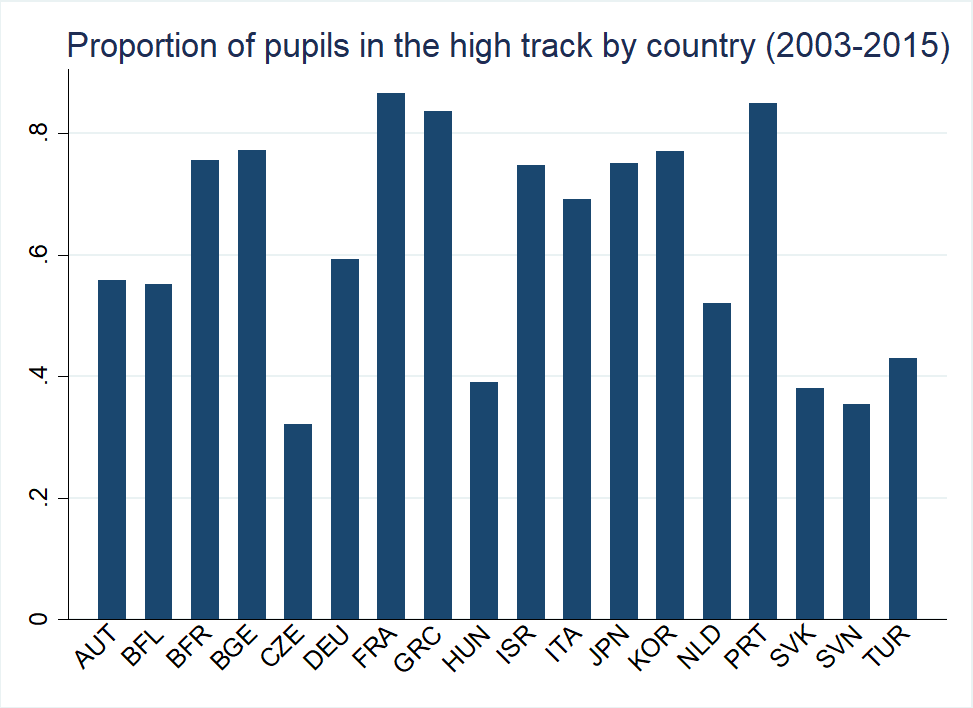 Note: For this information by year, click: here, but for most countries the picture does not change a lot year by year.
Note: For this information by year, click: here, but for most countries the picture does not change a lot year by year.
Are groups of pupils equally divided among the tracks?
Now let's focus on equal opportunities. Opportunities are unequal as soon as track allocation is not based on abilities and interests but on unrelated things, like the background of the pupils. For some small extent the background of the pupils is related to the abilities and interests of the pupils. But it is unlikely that the socio-economic status, migrant status, gender, or relative age of pupils really determines his or her abilities and interests. Thus, by looking at how track allocation differs by these background characteristics we can see whether opportunities are equal.I do not mean to say here that pupils with different background characteristics do not differ in performance. Migrant pupils might perform worse than native pupils due to language problems, less support at home when their parents are unfamiliar with the local education system, or other reasons. This lower performance might make it very understandable that migrant pupils are more often found in the lower track. However, we assume the underlying ability levels between native and migrant pupils are the same. And thus, more migrant than native pupils in the lower track is a sign of inequality in educational opportunities.
Figures 2 till 5 show for different background characteristics how the track allocation differs by groups. For instance, in Hungary 26% of pupils with low or middle education parents are in the high track, compared to 59% of pupils with high educated parents. In Israel this difference is much smaller (73% versus 75%). Also, for migrant status, gender or relative age, we see that groups of pupils differ in their track allocation. Interestingly for migrant pupils we see that in some countries they are more likely to be in the high track (for instance in Japan), while in other countries there are less likely to be in the high track (for instance in Germany). This most likely has to do with the type of migrants that lives in these countries.
Figure 2 (click on image to enlarge):
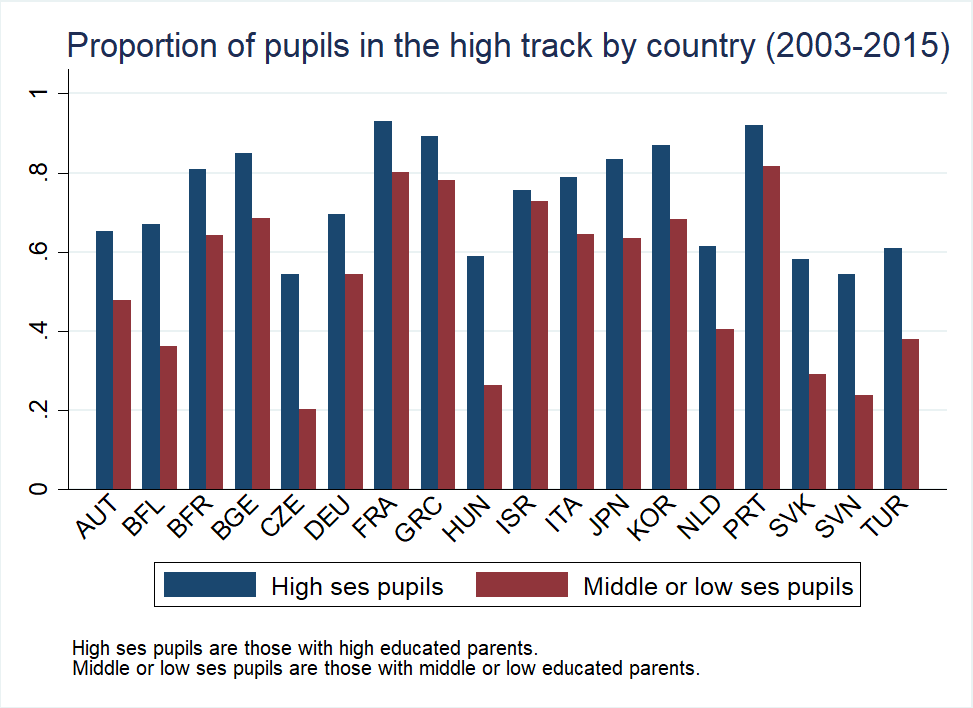 Figure 3 (click on image to
enlarge):
Figure 3 (click on image to
enlarge):
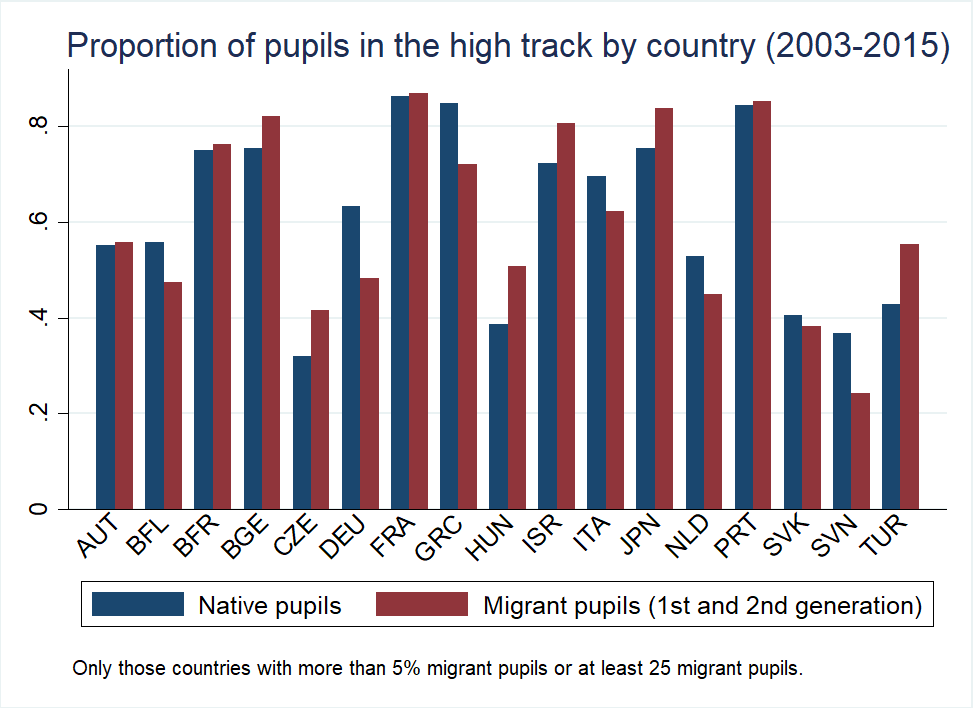 Figure 4 (click on image to
enlarge):
Figure 4 (click on image to
enlarge):
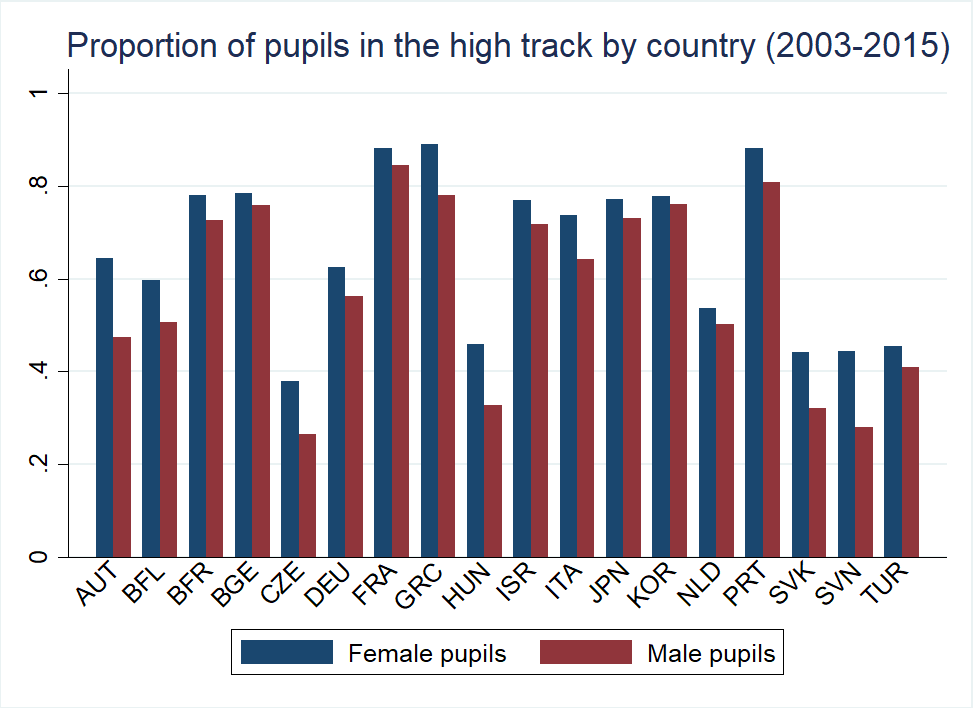 Figure 5 (click on image to
enlarge):
Figure 5 (click on image to
enlarge):
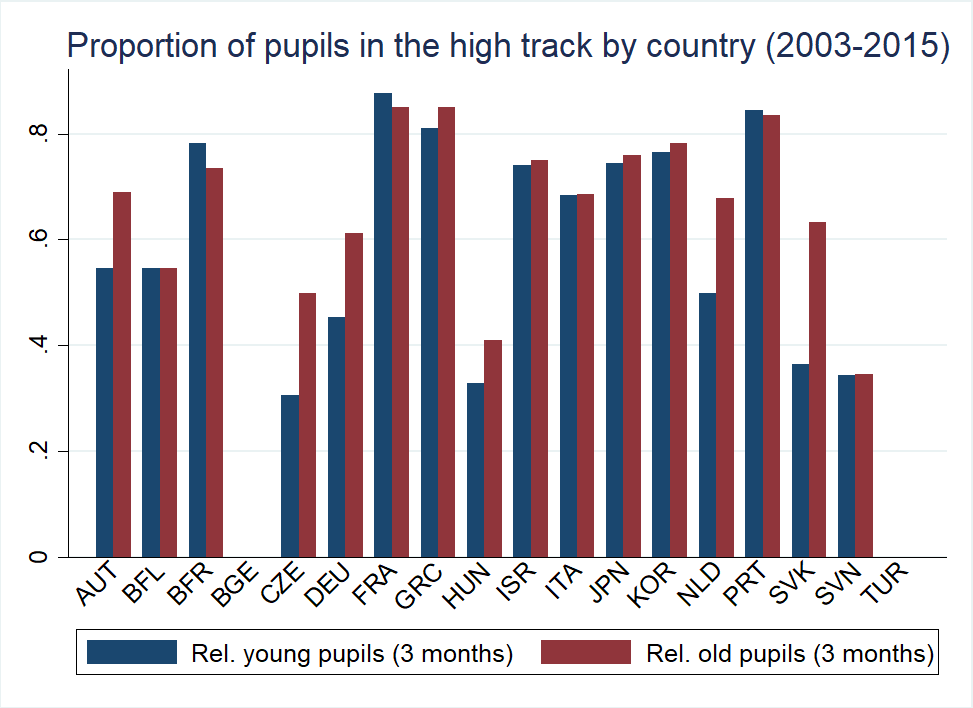 Note: These figures are also available by year, but they paint the same picture. Click for a figure by ses, by migrant status, by gender or by relative age.
Note: These figures are also available by year, but they paint the same picture. Click for a figure by ses, by migrant status, by gender or by relative age.
Interactive nudge: These figures show many interesting things and differences by countries. Many more than I take space here to tell about. Feel free to browse through them and find you own most interesting things!
Unequal opportunities in the track allocation?
At first sight, when looking at the figures above, there seems to be unequal opportunities for pupils across all four background characteristics looked at here. However, we did not yet look at significant differences and we now ignored that background characteristics are related to each other which might have exaggerate the differences in the figures. For instance, in some countries migrant status and socio-economic status are related, either positively (like in Japan) or negatively (like in Germany). To look in isolation at the four background characteristics, we include all background characteristics in a logistic regression. In this way, we take into account that some background characteristics might be related.Figures 6 till 9 show the odds ratio per country of going to the high track for a certain group of pupils. How do we read these figures? In Figure 6 we see that in France the odds ratio to go to the high track based on parental education is 3.3, with a confidence interval of 2.9 to 3.8. What this means is that in France the odds of going to the high track as opposed as going to the low track is 3.3 times higher for pupils with high educated parents than for pupils with middle or low education parents. If both groups of pupils had equal chances of going to the high or low track, these odds would be 1. In the figure this is indicated with the red horizontal line. If an odds ratio is (far) above or below the red horizontal line, this is a sign of inequal opportunities. In Figure 7 and 9 we see that in most countries there is no or very little inequality based on migrant status or on relative age, since all odds are very close to this red horizontal line. For parental education (Figure 6) or gender (Figure 8) we see that there seem to be inequal opportunities.
Figure 6 (click on image to enlarge):
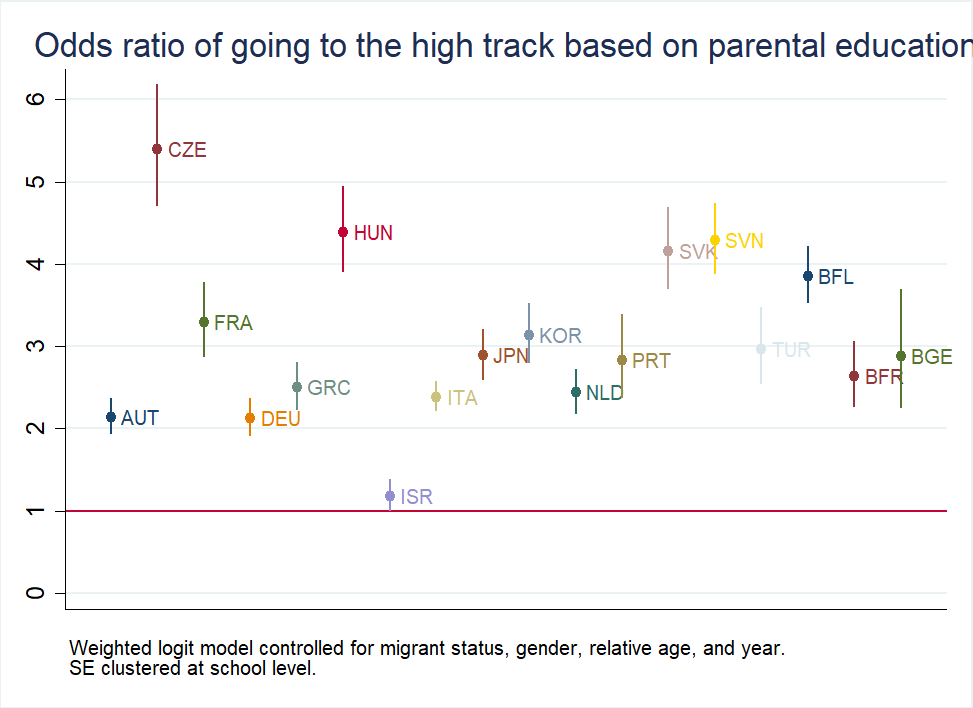 Figure 7 (click on image to
enlarge):
Figure 7 (click on image to
enlarge):
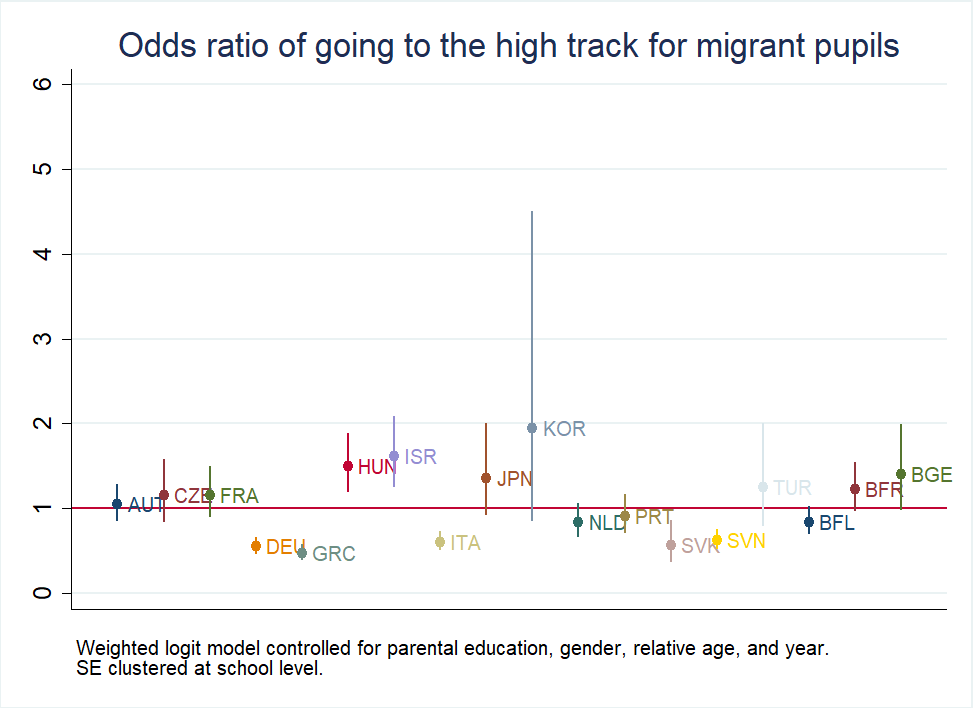 Figure 8 (click on image to
enlarge):
Figure 8 (click on image to
enlarge):
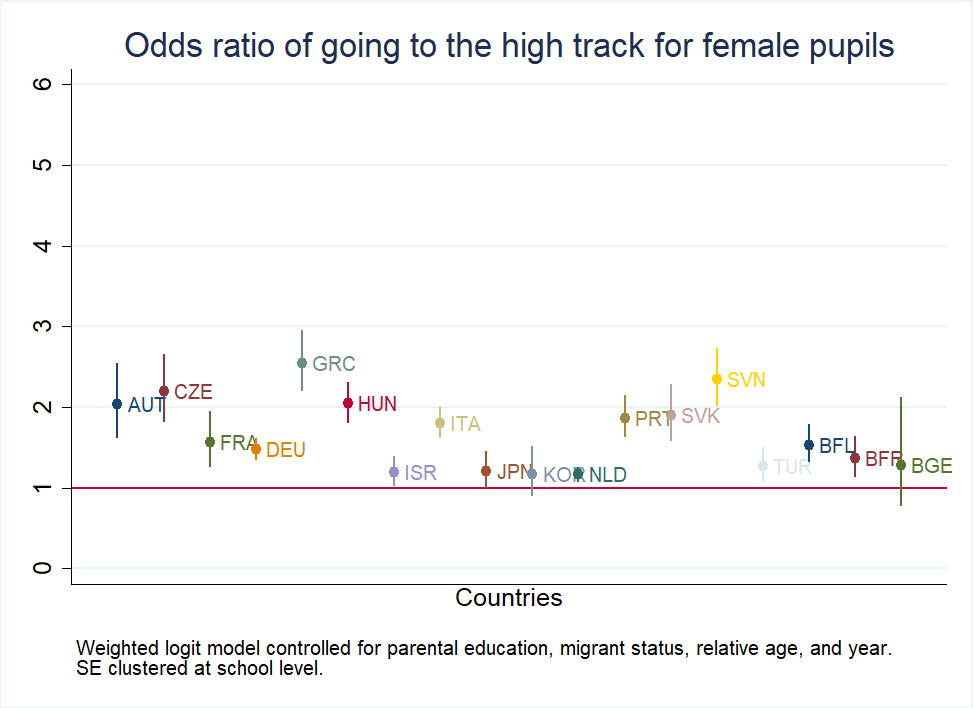 Figure 9 (click on image to
enlarge):
Figure 9 (click on image to
enlarge):
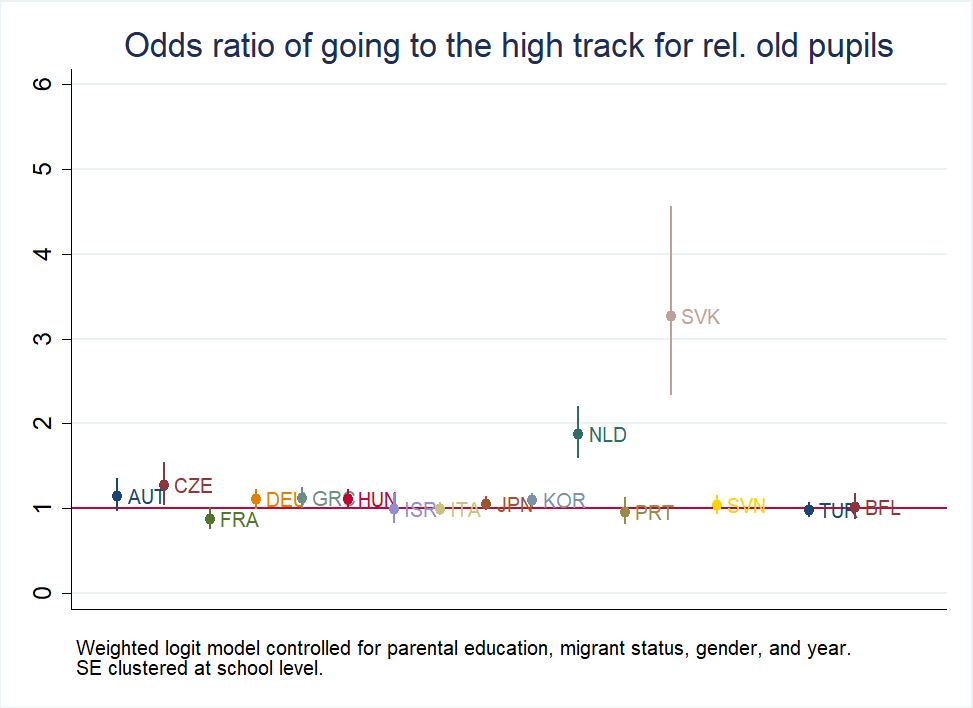
Here too: There are many interesting finds in each individual figure which make fascinating research questions. For instance: What is going on with the relative old pupils in Slovakia? or Why do boys in Greece do so bad internationally? I give myself limited space here to discuss them. Please study the figures yourself and email me what you find is most remarkable and maybe we can brainstorm together about how to answer the question and write a blog post on it.
To conclude
Is there inequality of opportunity in track allocation? Yes, there is. We saw inequality by the education level of parents and by gender, but in most countries not on migration status or relative age. But be careful with this conclusion: Just because in non-tracking countries there are no tracks, that doesn't mean there is no inequality of opportunity in what is being taught. We just don't have an easy way to show it.References: pdf
Technical details
- Data: PISA 2003 till PISA 2015, which can be found here.
- Data selections: Only OECD countries who track their pupils before the age of 15. I define a track as an educational program where at least 5% of pupils are allocated to. Pupils in programs with less than 5% of pupils are excluded. Figures are only including pupils who are in the modal grade.
- Do-file: here.